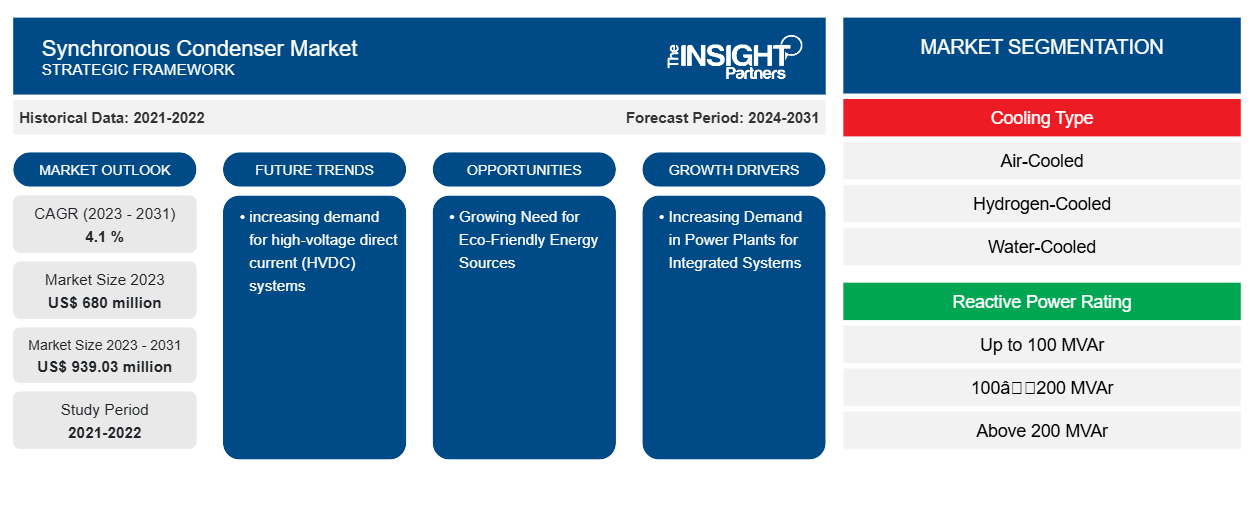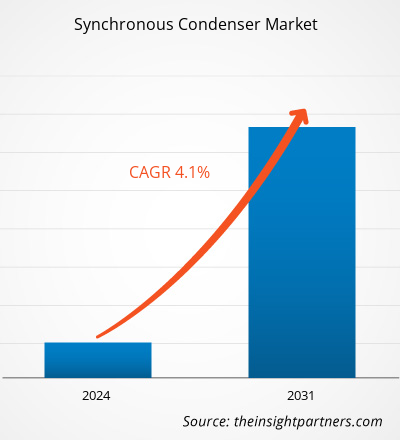The synchronous condenser market size is projected to reach US$ 939.03 million by 2031 from US$ 680 million in 2023. The market is expected to register a CAGR of 4.1 % in 2023–2031. The increasing demand for high-voltage direct current (HVDC) systems is likely to remain a key synchronous condenser market trend.
Synchronous Condenser Market Analysis
The growing need for sustainable energy sources is propelling the synchronous condenser market's strong expansion globally. The market is expanding due in part to the power plants' increasing requirement for integrated systems. An important opportunity in this context is the increase in government programs aimed at lowering air pollution. The market is nevertheless constrained by factors including increased capital and maintenance costs and strict regulations pertaining to synchronous condensers. Among the difficulties are the presence of inexpensive alternatives and the need to engage in an intricate and drawn-out installation procedure.
Synchronous Condenser Market Overview
Synchronous condensers are thought of as DC-excited synchronous motors that modify their power and temperature in accordance with the grid for transmitting electricity. The purpose of synchronous compensators, also known as synchronous condensers, is to continually regulate the voltage level in a network area. Depending on the excitation current value, they can either produce or consume reactive power. When it comes to power-factor correction in power grids, synchronous condensers offer an alternative to capacitor banks.
Customize This Report To Suit Your Requirement
You will get customization on any report - free of charge - including parts of this report, or country-level analysis, Excel Data pack, as well as avail great offers and discounts for start-ups & universities
Synchronous Condenser Market: Strategic Insights

-
Get Top Key Market Trends of this report.This FREE sample will include data analysis, ranging from market trends to estimates and forecasts.
Synchronous Condenser Market Drivers and Opportunities
Increasing Demand in Power Plants for Integrated Systems
There is a growing need for solutions that can improve power quality and grid stability as awareness of renewable energy sources grows. In power systems, synchronous condensers are essential because they regulate voltage and sustain reactive power. The power generating and distribution network's overall dependability is preserved, power plant operations are optimized, and grid fluctuations are reduced thanks to the integration of these condensers. As the need for grid stability increases, synchronous condenser use is anticipated to increase, propelling the market ahead.
Growing Need for Eco-Friendly Energy Sources
The term "clean energy" describes energy derived from sources that do not emit air pollutants. Power produced from resources that are continually being replenished is known as renewable energy. These sustainable energy sources, which include wind and solar energy, won't run out like fossil fuels and gas do. Sustainable energy sources are mostly renewable, nevertheless. Thus, renewable energy sources are another name for flawless green clean energy. Thus, the growing need for eco-friendly energy sources is anticipated to present new opportunities for the synchronous condenser market players during the forecast period.
Synchronous Condenser Market Report Segmentation Analysis
Key segments that contributed to the derivation of the synchronous condenser market analysis are cooling type, reactive power rating, starting method, and application.
- Based on the cooling type, the synchronous condenser market is segmented into air-cooled, hydrogen-cooled, and water-cooled. The hydrogen-cooled segment held a larger market share in 2023.
- By reactive power rating, the market is segmented into up to 100 MVAr, 100–200 MVAr, and Above 200 MVAr.
- By starting method, the market is segmented into pony motors, static frequency converters, and others.
- By application, the market is segmented into metal and mining, electrical utilities and grid operators, marine, oil and gas, and others.
Synchronous Condenser Market Share Analysis by Geography
The geographic scope of the synchronous condenser market report is mainly divided into five regions: North America, Asia Pacific, Europe, Middle East & Africa, and South America/South & Central America. In terms of revenue, Europe accounted for the largest synchronous condenser market share. High voltage direct current (HVDC) systems, a sizable customer base, the quick growth of the renewable energy industry, and the presence of significant regional companies are all credited for this. Furthermore, the existence of countries such as Germany, the United Kingdom, France, and Spain is expected to support the expansion of the European market.
Synchronous Condenser Market Regional InsightsThe regional trends and factors influencing the Synchronous Condenser Market throughout the forecast period have been thoroughly explained by the analysts at The Insight Partners. This section also discusses Synchronous Condenser Market segments and geography across North America, Europe, Asia Pacific, Middle East and Africa, and South and Central America.
Synchronous Condenser Market Report Scope
| Report Attribute | Details |
|---|---|
| Market size in 2023 | US$ 680 million |
| Market Size by 2031 | US$ 939.03 million |
| Global CAGR (2023 - 2031) | 4.1 % |
| Historical Data | 2021-2022 |
| Forecast period | 2024-2031 |
| Segments Covered |
By Cooling Type
|
| Regions and Countries Covered |
North America
|
| Market leaders and key company profiles |
|
Synchronous Condenser Market Players Density: Understanding Its Impact on Business Dynamics
The Synchronous Condenser Market is growing rapidly, driven by increasing end-user demand due to factors such as evolving consumer preferences, technological advancements, and greater awareness of the product's benefits. As demand rises, businesses are expanding their offerings, innovating to meet consumer needs, and capitalizing on emerging trends, which further fuels market growth.

- Get the Synchronous Condenser Market top key players overview
Synchronous Condenser Market News and Recent Developments
The synchronous condenser market is evaluated by gathering qualitative and quantitative data post primary and secondary research, which includes important corporate publications, association data, and databases. The following is a list of developments in the market for speech and language disorders and strategies:
- In November 2023, at Ireland's Shannon Bridge B, Siemens unveiled a hybrid grid stabilization system. This novel device combines a 160 MWh battery with a flywheel-equipped synchronous condenser. This is the first time these two technologies have been combined to provide a single, cohesive grid connection solution. Improving grid stability and optimizing the use of renewable energy sources are the main goals. Siemens hopes to successfully handle grid difficulties and expedite the shift towards a more sustainable energy infrastructure by utilizing this cutting-edge hybrid solution. (Source: Siemens, Press Release)
- In November 2023, General Electric announced that EDF SEI chose a consortium made up of GE Vernova's Power Conversion division and Eiffage Énergie Systèmes (consortium manager) to provide and construct a turnkey synchronous condenser system at the EDF. (Source: General Electric, Press Release)
Synchronous Condenser Market Report Coverage and Deliverables
The “Synchronous Condenser Market Size and Forecast (2021–2031)” report provides a detailed analysis of the market covering below areas:
- Market size and forecast at global, regional, and country levels for all the key market segments covered under the scope
- Market dynamics such as drivers, restraints, and key opportunities
- Key future trends
- Detailed PEST/Porter’s Five Forces and SWOT analysis
- Global and regional market analysis covering key market trends, major players, regulations, and recent market developments
- Industry landscape and competition analysis covering market concentration, heat map analysis, prominent players, and recent developments
- Detailed company profiles
Frequently Asked Questions
What is the estimated market size for the global synchronous condenser market in 2023?
What are the driving factors impacting the global synchronous condenser market?
What are the future trends of the global synchronous condenser market?
Which are the key players holding the major market share of the global synchronous condenser market?
What will be the market size of the global synchronous condenser market by 2031?
- Historical Analysis (2 Years), Base Year, Forecast (7 Years) with CAGR
- PEST and SWOT Analysis
- Market Size Value / Volume - Global, Regional, Country
- Industry and Competitive Landscape
- Excel Dataset
Recent Reports
Testimonials
Reason to Buy
- Informed Decision-Making
- Understanding Market Dynamics
- Competitive Analysis
- Identifying Emerging Markets
- Customer Insights
- Market Forecasts
- Risk Mitigation
- Boosting Operational Efficiency
- Strategic Planning
- Investment Justification
- Tracking Industry Innovations
- Aligning with Regulatory Trends





















 Get Free Sample For
Get Free Sample For